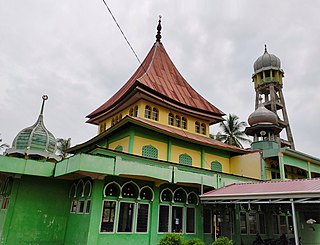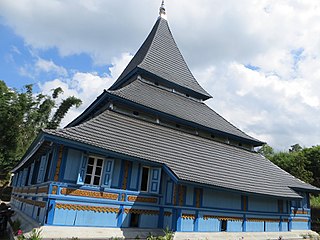Related Research Articles

West Sumatra is a province of Indonesia. It is on the west coast of the island of Sumatra and includes the Mentawai Islands off that coast. West Sumatra borders the Indian Ocean to the west, as well as the provinces of North Sumatra to the north, Riau to the northeast, Jambi to the southeast, and Bengkulu to the south. The province has an area of 42,119.54 km2 (16,262.45 sq mi),or about the same size as Switzerland,with a population of 5,534,472 at the 2020 census. The official estimate at mid 2022 was 5,640,629. The province is subdivided into twelve regencies and seven cities. It has relatively more cities than other provinces outside Java, although several of them are relatively low in population compared with cities elsewhere in Indonesia. Padang is the province's capital and largest city.

Islam is the largest religion in Indonesia, with 87% of the Indonesian population identifying themselves as Muslims, based on civil registry data in 2022. In terms of denomination, the overwhelming majority are Sunni Muslims; the Pew Research Center estimates them as comprising ~99% of the country's Muslim population in 2011, with the remaining 1% being Shia who are concentrated around Jakarta and about 400,000 Ahmadi as well. Indonesia is the Muslim-majority country, and its Muslim population is the second largest in the world, after Pakistan.
The Indonesian constitution provides some degree of freedom of religion. The government generally respects religious freedom for the six officially recognized religions and/or folk religion. All religions have equal rights according to the Indonesian laws.

The Ganting Grand Mosque is a Sunni mosque located in Ganting, Padang, West Sumatra, Indonesia. Construction began in 1805, making it the oldest in Padang and one of the oldest in Indonesia. It is a Cultural Property of Indonesia.

Zakiah Daradjat was an Indonesian Islamic psychologist, educator, and professor of psychology at the Syarif Hidayatullah State Islamic University Jakarta.

The Ministry of Religious Affairs is an Indonesian ministry that administers religious affairs. It is responsible to the president, and is led by a minister.

Andalas Grand Mosque is a mosque located in Andaleh Street no.56, Andaleh, East Padang district, Padang, West Sumatra, Indonesia. The mosque consists of a green building with two floors which has area of 1,200 m2, and a minaret in the southeast and an entrance gate in the south.

The Nurul Islam Great Mosque or also known as Sawahlunto Great Mosque is one of the oldest mosques in Indonesia located in Kubang Subdistrict of North Sirakuak, District of Lembah Segar, Sawahlunto town, West Sumatra. The location is about 150 meters from the Sawahlunto Railway Museum.

Balai Gadang Mungo Grand Mosque is an old mosque in Indonesia, located in Jorong Balai Gadang Bawah, Nagari Mungo, Luhak District, Lima Puluh Kota Regency, West Sumatra. The mosque was built in 1914, making it one of the oldest mosques in Indonesia, and the oldest mosque in Nagari Mungo.

Rao Rao Mosque is one of the oldest mosques in Indonesia located in Nagari Rao Rao, Tarab River, Tanah Datar Regency, West Sumatra. It is located on the road from Batusangkar bound to Bukittinggi, precisely in Rao Rao. This mosque of Minangkabau and Persian architecture was built in 1908 with a roof made from fibers before being changed to zinc.

The Bingkudu Mosque is one of the oldest mosques in Indonesia. It was founded by the Padri in the wake of the Padri War in West Sumatra in 1823. This mosque with typical Minangkabau style architecture is located in Jorong Bingkudu, Nagari Canduang Koto Laweh, Canduang District, Agam Regency, West Sumatra. When it was first built, the building of the mosque was made of wood on its floor, pole, and wall.

Jamik Sungai Jambu Mosque is one of the oldest mosques in Indonesia located in Jorong Sungai River, Sungai Jambu Nagari, Pariangan District, Tanah Datar Regency, West Sumatra. The mosque was built in 1918 at the foot of Mount Marapi, and during its development it has experienced a number of improvements both in terms of outlook and management. The mosque had ranked first for several times including in 2012, in the assessment of environmentally-oriented mosques for the provincial level which is conducted by the Indonesian Mosque Council.

Jami Mosque of Taluak is one of the oldest mosques in Indonesia, located in Taluak IV Suku Nagari, Banuhampu District, Agam Regency, West Sumatra. The location of the mosque is close to the border of Bukittinggi, thus it is also known as Jamik Taluak Mosque Bukittinggi.

Koto Baru Grand Mosque is one of the oldest mosques in Indonesia located in Koto Baru Nagari, Sungai Pagu District, South Solok Regency, West Sumatra.

Islam Nusantara or Indonesian (Islamic) model is a term used to refer to the empirical form of Islam that was developed in the Nusantara. This term was introduced and promoted by the Indonesian Islamic organization Nahdlatul Ulama (NU) in 2015, as an alternative for the interpretation and representation of global Islam that is currently dominated by Arabization—i.e. Saudi Wahhabism.

The Tuo Koto Nan Ampek Mosque, also known as Gadang Balai Nan Duo Mosque is one of the oldest mosques in Indonesia located in Koto Nan Ampek Nagari, now administratively included into the area of Balai Nan Duo village, West Payakumbuh District, city of Payakumbuh, West Sumatera. The Minangkabau architecture is thought to have been built in 1840 which was originally covered with fiber roofs before being replaced with zinc. Currently, other than being used for Muslim worship activities, this single-level mosque is also used by the surrounding community as a means of religious education.

Nurul Huda Mosque is one of the oldest mosques in Indonesia, located in Baringin District, Sawahlunto, West Sumatra. The mosque, built during the Dutch occupation, has a rectangular building with a tower blending into the main building. Currently, in addition to a function as a place of worship for Muslims, this two-story mosque is also used as a means of religious education for the surrounding community.

Islam is the most common religion in the Indonesian province of West Sumatra, embraced by 97.42% of the population. The Muslim population increases to 99.6% if it excludes the Mentawai Islands, where the majority of the non-Muslim (Protestant) West Sumatrans reside. Islam in West Sumatra is predominantly Sunni, though there is a small Shia Islamic pocket within the coastal city of Pariaman. The Minangkabau people, indigenous to West Sumatra, comprise 88% of the West Sumatran population today and have historically played an important role within Indonesia's Muslim community. Up until today, the region is considered one of the strongholds of Islam in Indonesia.
In the context of Muslim society in Indonesia, Traditionalism or traditionalist Islam refers to a religious strand which puts emphasis on preserving traditionally established local rituals and scholarship. Traditionalist Muslims refer to themselves as ahlussunnah wal-jamā'ah or aswaja. Traditionalism is often contrasted with modernism, which is inspired by modernity and rationalism. Traditionalism has been the most adhered Muslim religious orientation in the history of contemporary Muslim Indonesia. The extent of traditionalism widely overlaps with the influence of a socio-religious organization Nahdlatul Ulama, the biggest Muslim organization in Indonesia. Traditionalism is also a critical element within the Muslim intellectual movement known as Islam Nusantara.
References
- Footnotes
- Bibliography
- "Dibangun Sejak 1930, Jarang Disentuh Pemerintah". Padang Ekspres . 2012-07-30. Retrieved 2012-08-10.
- "Masjid pun Dinilai". Kementerian Agama. 2010-06-09. Retrieved 2012-08-10.









